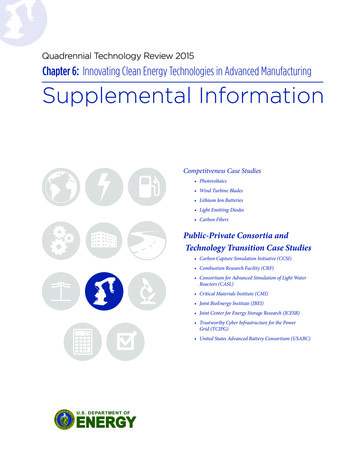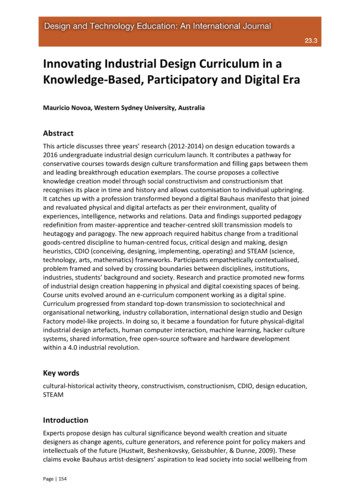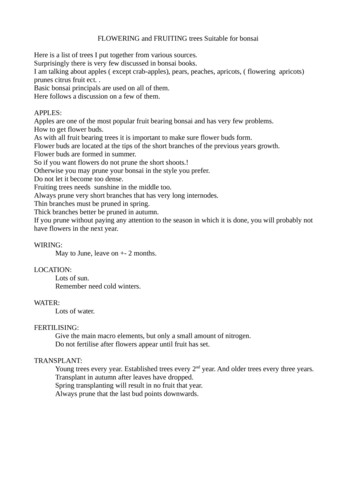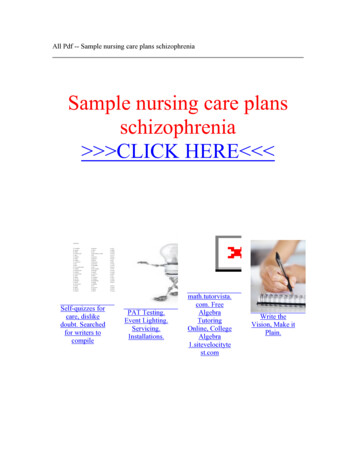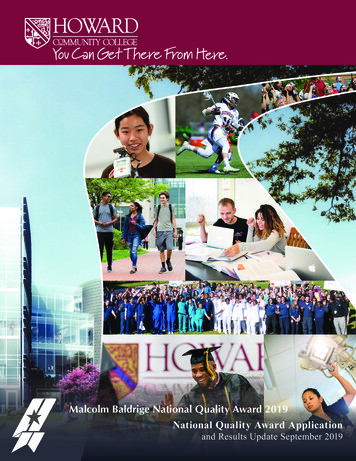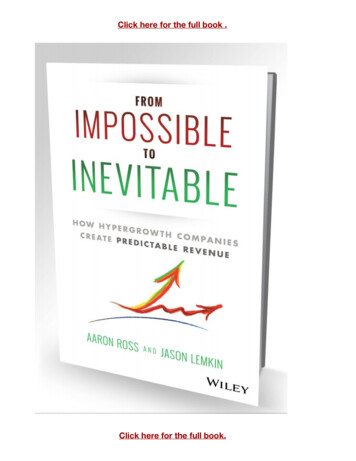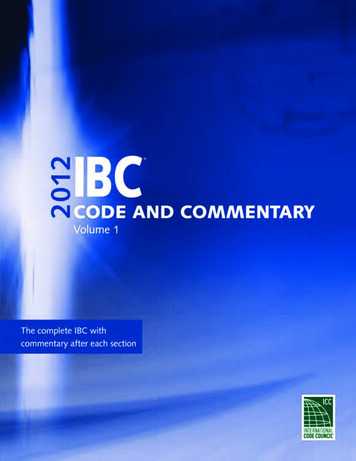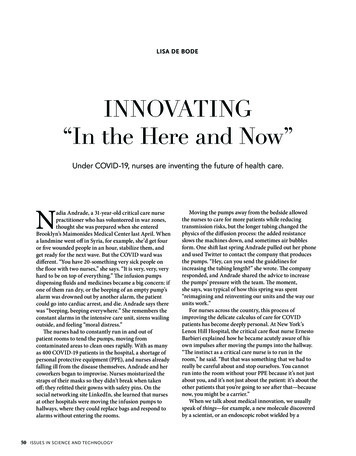
Transcription
LISA DE BODEINNOVATING“In the Here and Now”Under COVID-19, nurses are inventing the future of health care.Nadia Andrade, a 31-year-old critical care nursepractitioner who has volunteered in war zones,thought she was prepared when she enteredBrooklyn’s Maimonides Medical Center last April. Whena landmine went off in Syria, for example, she’d get fouror five wounded people in an hour, stabilize them, andget ready for the next wave. But the COVID ward wasdifferent. “You have 20-something very sick people onthe floor with two nurses,” she says. “It is very, very, veryhard to be on top of everything.” The infusion pumpsdispensing fluids and medicines became a big concern: ifone of them ran dry, or the beeping of an empty pump’salarm was drowned out by another alarm, the patientcould go into cardiac arrest, and die. Andrade says therewas “beeping, beeping everywhere.” She remembers theconstant alarms in the intensive care unit, sirens wailingoutside, and feeling “moral distress.”The nurses had to constantly run in and out ofpatient rooms to tend the pumps, moving fromcontaminated areas to clean ones rapidly. With as manyas 400 COVID-19 patients in the hospital, a shortage ofpersonal protective equipment (PPE), and nurses alreadyfalling ill from the disease themselves, Andrade and hercoworkers began to improvise. Nurses moisturized thestraps of their masks so they didn’t break when takenoff; they refitted their gowns with safety pins. On thesocial networking site LinkedIn, she learned that nursesat other hospitals were moving the infusion pumps tohallways, where they could replace bags and respond toalarms without entering the rooms.50ISSUES IN SCIENCE AND TECHNOLOGYMoving the pumps away from the bedside allowedthe nurses to care for more patients while reducingtransmission risks, but the longer tubing changed thephysics of the diffusion process: the added resistanceslows the machines down, and sometimes air bubblesform. One shift last spring Andrade pulled out her phoneand used Twitter to contact the company that producesthe pumps. “Hey, can you send the guidelines forincreasing the tubing length?” she wrote. The companyresponded, and Andrade shared the advice to increasethe pumps’ pressure with the team. The moment,she says, was typical of how this spring was spent“reimagining and reinventing our units and the way ourunits work.”For nurses across the country, this process ofimproving the delicate calculus of care for COVIDpatients has become deeply personal. At New York’sLenox Hill Hospital, the critical care float nurse ErnestoBarbieri explained how he became acutely aware of hisown impulses after moving the pumps into the hallway.“The instinct as a critical care nurse is to run in theroom,” he said. “But that was something that we had toreally be careful about and stop ourselves. You cannotrun into the room without your PPE because it’s not justabout you, and it’s not just about the patient: it’s about theother patients that you’re going to see after that—becausenow, you might be a carrier.”When we talk about medical innovation, we usuallyspeak of things—for example, a new molecule discoveredby a scientist, or an endoscopic robot wielded by a
nur sing innovat ionIllustration by Shonagh Raesurgeon. But the truer nature of nursing’s inventiveness,and its historically complex relationship with patientsand technology, has been revealed as nurses have creatednew methods of COVID care on the fly, keenly aware ofthe risks they are taking on themselves. Nurses’ stories ofrapid improvements in care, communication, and logisticsreveal the deep and unexpected role of trust in innovation,as well as how changes instituted in the pandemic couldshape health care for years to come.An evolving standard of careNurses have long been key players in hospitals, butCOVID-19 has underscored their uniquely essential role.The strikingly high death rates of the COVID patients whofirst entered New York hospitals last March—measuredat three hospitals at 25.6%—had fallen by August, whenthe death rate was 7.6% at those same hospitals. Anotherstudy in the United Kingdom found similarly higherrates of survival in critical care units over time. Evenafter accounting for age, ethnicity, and other factors,the researchers attributed the improvement to changesin care, and lower bed occupancy rates—meaning morestaff attention per patient.These changes included drug therapies, notably thesteroid dexamethasone, but also an array of proceduresand techniques including proning (turning patientsonto their stomach to improve blood oxygen levels),managing patients’ needs on mechanical ventilation, andcoaching and encouraging patients not on ventilators toadopt new behaviors. News of these innovations diffusedWINTER 202151
nur sing innovat ionfrom hospital to hospital, and ward to ward, through formalchannels—including briefings by supervising physicians andguidelines from the Society of Critical Care Medicine—aswell as informal channels, including social media.The importance of nurses became clear early in thepandemic, even though the public conversation focused onthe availability of hardware such as ventilators. “It’s all welland good [to have] the industrial community coming togetherand giving us another 5,000 ventilators overnight,” saysBilal Mateen, a physician and clinical data science fellow atthe UK’s Alan Turing Institute. “I can’t train another 5,000nurses on how to use them overnight.”This became only more obvious as the wards filled up.In normal times, one nurse tends to only one patient in anintensive care unit. “That’s what makes an ICU: the patientto-nurse ratio. That’s why an ICU is an ICU,” says CameronKyle-Sidell, an emergency room doctor at MaimonidesMedical Center. In March, those ratios went up to fourto-one, or seven-to-one in extreme cases. Kyle-Sidell addsthat while bedside care is seen as guided by doctors, in factit is generally the domain of nurses. “Every moment-tomoment-to-moment thing, it’s the nurse who is the eyes onthe patient,” he says. “Once you exceed your capacity to reallywhen you have to put on all that PPE,” Barbieri said.And some of the innovations in therapy requiredfurther changes in the way nurses worked with patients.Some patients did much better if they were not intubatedand put on a ventilator, but were instead given oxygenthrough a nasal cannula (a two-pronged tubing devicethat is placed in a patient’s nostrils). What these patientsthen needed was a lot of supervision, or “coaching,” toself-prone and not pull out their cannulas on bathroombreaks. Kyle-Sidell recalls treating several patients whowere found face down in hospital lavatories, sufferingfrom lack of oxygen. “Our job was to circle [the ward]and make sure they kept their oxygen on—reallyencourage them to turn over and flip over and not get outof bed, and to eat and drink,” he says. “But it required atremendous amount of caretaker attention.”As the idea of what constituted proper care evolved,all this work coaching and encouraging added to thekinds of care that floor nurses are managing, says LewisJ. Kaplan, the president of the Society of Critical CareMedicine. “When you are sick with COVID in thehospital, you’re really worried you’re going to die. Andevery day and every moment that you are capable of doingNurses spent the early months of the pandemic “reimagining andreinventing our units and the way our units work.”watch the patients, that’s when it turns into a disaster.”A long-known truth about modern hospitals is that theyare not built to function at very high capacities, says Mateen,who analyzed occupancy data from hospitals across theUnited Kingdom. He says bed occupancy rates—and theavailability of nurses and other staff—has a “clear effect” onpatients’ survival rates. “If you get admitted to an intensivecare unit on a day where there’s more than 85% of themechanical ventilation beds occupied, your risk of dying issignificantly higher,” he says.Modifications to care followed quickly. Before March wasout, teams around the country began practicing proning,the technique, first documented in the 1970s, of turningpatients onto their stomachs to increase the amount of oxygenin their blood. Barbieri, who regularly “flipped” patients,explained that in an ideal situation, a registered nurse wouldwork with a team of four or five to perform the maneuver onan intubated patient. The process is physically difficult forstaff and hard on patients, he says, with dangers that includekinking or ripping out IV lines, bending endotracheal tubes,and causing the patient to bleed because of skin breakdownon the face. “If the patient goes into cardiac arrest it’s veryhard to flip them and start doing compressions—especially52ISSUES IN SCIENCE AND TECHNOLOGYsomething for yourself that helps keep your lungs open[means] you are now engaged in your own care where itreinforces hope,” he says, adding that “the power of hopeand a positive outlook really cannot be overstated.”But at the same time, the extra workload—frommanaging machines to managing emotions—puts anenormous burden on nurses. “They’re stretched thin,”Kaplan says, “and it is potentially dangerous becausethe more tired you are, the more likely you are to err,especially when you are dealing with doffing [PPE] afterhaving been in a COVID room.”Even as patient survival rates rose dramaticallythrough the spring and early summer, COVID-19 tooka toll on nurses themselves. National Nurses United(NNU), the nation’s largest nurses’ union, estimates thatby mid-September 2020, close to 259,000 health careworkers had been infected, and more than 2,100 died, ofwhom at least 213 were registered nurses. These deathsrevealed entrenched health disparities: Filipino nurses,who make up just 4% of nurses nationally, accounted for31.5% of the dead, and Black nurses, who comprise 12.4%of the nursing workforce, accounted for 17.8%, accordingto NNU. Among factors placing these nurses at greater
nur sing innovat ionrisk, Filipino nurses are more often employed in higher-riskpositions such as ICUs, emergency rooms, and inpatientsettings, according to Jennifer Nazareno, an assistantprofessor of public health and entrepreneurship at BrownUniversity and the codirector of the Philippine HealthInitiative for Research, Service, and Training. Black nurses,in turn, more frequently work in underfunded hospitals thatlack PPE and adequate protection, according to the NationalBlack Nurses Association.Nurses’ unions have long been leaders in championingimproved standards of care and working conditions, andduring the pandemic they have continued that work. Shortlyafter the first cases of coronavirus hit, NNU surveyed theamount of PPE available in hospitals, discovering that theywere largely unprepared. On August 5, NNU organizedmore than 200 protests demanding more PPE, a safeworkload of patients, and other protections. In September,California started requiring hospitals to store N95 masks attypical usage rates in defiance of the industry’s just-in-timeinventory model. In November, nurses again rang the alarmbells about the shortage of staff; “extreme levels of moraldistress,” caused by the lack of support and supplies to carefor patients; and the need for a course correction to avoid“catastrophic levels of deaths and suffering.”These actions build on years of union work to improvethe safety of nurses and their patients, famously includingthe RN Mary Magee, who contracted HIV from anaccidental needle jab in San Francisco General Hospital’sWard 5B in the 1980s. She then led a union-backed effortto have hospitals purchase safer needles, which are nowstandard in California, and Congress soon mandated saferstandards nationwide. Martha Dawson, the president of theNational Black Nurses Association, remembers workingwith early cases of HIV at the University of Alabama atBirmingham, when nurses used Coca-Cola bottles, or evenIV bottles, until needle storage containers were invented.“Out of chaos can also come creativity and innovation,”she says.“The habit of ready and correct observation”As with HIV, the COVID-19 pandemic has again exposedtensions around nurses’ central role as innovators inpatient care that go back to the very origins of Westernnursing. Florence Nightingale’s 1860 manual, Notes onNursing, introduced guidelines on ventilation, noise, diet,and sleep—many of which remain valid today. It ends witha chapter on the powers of observation that pushes backagainst the idea that nurses are doing innately “female”work by staking their vocation firmly in the domain ofscientific knowledge production. It “may safely be said, notthat the habit of ready and correct observation will by itselfmake us useful nurses, but that without it we shall be uselesswith all our devotion,” she wrote.As hospitals evolved, nurses took on the task of organizinglarge wards for the sick. Over the years, prominent nurseswould strive for professional recognition, defending nursingas skilled, paid work, and distinguishing it from unseendomestic labor. By the time of the 1918 Spanish flu pandemic,when a third of the world’s population was infected, nursingcare might have been the single most effective treatment toimprove a patient’s chances of survival, the historian John M.Barry writes in The Great Influenza.As new technologies for diagnosis and treatment,including x-rays and antibiotics, entered the field of medicineafter World War II, nurses’ work became associated with therunning of hospitals and equipment rather than being seenas an area of constant innovation itself. “Nursing was the softtechnology that allowed physicians to use the new hardwareof diagnosis,” Margarete Sandelowski writes in Devices andDesires: Gender, Technology, and American Nursing.The role of trust in innovationThe pandemic, however, shattered some of the fixedhierarchies of knowledge production, with hackathons,WhatsApp threads, and social media channels hostingfeverish exchanges between global networks of healthcare professionals. And it has facilitated new avenues forinnovation.“So often people talk about the nurses as sort of doinglots of workarounds. So basically [they work with] what’s infront of you and what’s going to work best in that particularsituation,” says Patricia Davidson, the dean of the JohnsHopkins University School of Nursing. What nurses innovateon is the stuff of everyday life in the ward. “When you’re inthe here and now, and the issue is in front of you—that’s apretty good motivation to do something different and better,”Davidson says. “Just the pain of watching the suffering ofanother is a pretty good motivation to be creative.”One area of focus has been preventing and controlling thespread of the virus. In some hospitals, nurses have trainedstaff on safe ways to don and doff PPE. They have done this byappointing a safety officer who watches staff putting on andtaking off protective gear on COVID wards. “Their job is tomake sure that not only do you place it correctly when you’restill in the clean space before you enter the COVID ward,”says Jason Farley, a professor of nursing at Johns Hopkins,“but when you’re contaminated and you’re removingeverything and you’re coming out a different exit of thatward, that you remove it in such a way as to protect yourselfand to protect the environment into which you’re movingback—either clean spaces or other parts of the hospital.”Farley has been working on innovations that can protectnurses, but he is keenly aware of nurses’ need to build andmaintain connections to patients. He recently designedand built a portable testing booth in partnership with theUniversity of Maryland’s School of Engineering. The pod usesWINTER 202153
nur sing innovat ionpositive pressure ventilation (similar to the mechanismthat was employed inside iron lungs to help polio patientsbreathe) so that air exhaled by the patient does not comeinto the booth, minimizing the risk of transmission tothe tester. And the booth is built of plexiglass so that thepatient can see the health care worker’s unmasked face. Itseems minor, he explains, but it’s invaluable for lip-reading,and “being able to see a person’s face helps calm someonewhen they’re nervous.”As he designed the booth, Farley wrestled with afamiliar contradiction between facilitating connectionand keeping the nurse and patient safe by separating them.The trick, he says, is to remove emotional barriers betweenpatient and caregiver. Cultivating transparent personalrelationships, Farley says, is something nurses excel at. Andthat drives patients’ willingness to both accept potentiallyuncomfortable care and change their own behaviors. “It’sone of the reasons why nursing is consistently voted themost trusted profession of all,” he says.Farley’s invention brings up a larger truth: as muchas the booth may be seen as a “hard” technology, its useis inseparable from the nurses who operate it. The timelag between when health research occurs and whenits lessons become standard medical practice takes anaverage of 17 years, explains Heather Ross, who holds ajoint appointment as an assistant professor at ArizonaState University’s School for the Future of Innovation inSociety and ASU’s Edson College of Nursing and HealthInnovation. Nurses are key to the process of convincingpeople that the change is worthwhile. “You have to talkabout diffusion of innovation and uptake of innovationwhenever you talk about innovation,” Ross says. “And thatdiffusion of innovation and uptake—you can’t extract itfrom talking about trust. It’s all tied together.”Easing friction between patients and the machinesaround them helps build some of that trust, says LisaWolf, the director of the Institute of Emergency NursingResearch at the Emergency Nurses Association and anadjunct professor at the University of MassachusettsAmherst College of Nursing. She calls this the “midwiferyaspect” of the profession, which has its own remedies formanaging the machines of care. She lists a few: pouringa bit of ginger ale into a patient’s nasogastric tube tounclog it; using hot packs on a patient’s hand to dilatethe veins ahead of inserting an IV (as opposed to directlyinserting the needle); putting the tip of a nasogastric tubein ice water so it doesn’t curl as it slides down a patient’sthroat—all of the “little things” that make people feel morecomfortable.But ultimately, it may be the fact that nurses areoften the first to touch a newborn baby and the last totouch a dying person that makes the technology theyuse sometimes seem secondary, compared with their54ISSUES IN SCIENCE AND TECHNOLOGYprominent social and spiritual role in medicine. “BecauseAmericans are so afraid of death and utterly unpreparedfor it,” Wolf says, “the thing that gives them peace is tohave somebody there talking to them, holding their hand.To have a nurse with you in those last moments I think isthe central focus of nursing—assisting people to health orto a dignified death.”Accordingly, the stress of the pandemic has givennurses space to innovate in death too. “We hold people’shands and we tell them that we’re going to convey theirmessages. We sit there and are their family in their lastminutes,” says Andrade, the critical care nurse whoworked to rearrange the pumps at Maimonides MedicalCenter. Hoping to ease families’ suffering, Andradeused her personal phone to connect dying patients andtheir families. Sometimes she left voice messages for thefamilies. Around the country, other nurses performed thesame ritual, wrapping their phones in plastic.This has since become more standardized, with someICU units installing iPads in wards in anticipation of moreCOVID deaths. “We were trying to find innovative waysto make things happen, and technologies have improved alot,” Andrade says. “But I hope nobody will ever get used toit. It’s still not close to the warm touch—somebody holdingyour hand, kissing you, and saying what they wantedto say in person. I hope there will be a lot of research tounderstand and navigate feelings about how we can do itbetter next time.”The possibilities of telemedicineOne innovation accelerated by the pandemic that is likelyto persist is telemedicine, where medical professionalsconsult with patients over phones or computers. Althoughsome insurers had previously offered telehealth services, itwasn’t widely available before late February, when the USCenters for Disease Control and Prevention recommendedthat health care providers offer clinical services throughvirtual means, and Medicare and Medicaid moved rapidlyto broaden access: by the last week of March, teleconsultshad risen by 154% over the previous year. Telemedicine hasmany advantages: expanding access to care when patientscan’t be seen at the hospital, preserving PPE, and limitingexposure. Accordingly, 2020 has seen billions of dollars ininvestment flowing toward telehealth, which is seen as anarea ripe for both rapid growth and high profits.For nurses, this new mode of care brings up oldconcerns: will they be allowed to engineer the experienceto increase the trust and comfort of patients, or will it bea way for companies to turn the health care experienceover to poorly paid contractors reading from customerservice scripts? By introducing distance into an intimateexamination, telehealth could remove agency from nurses,says Michelle Mahon, the assistant director of nursing
nur sing innovat ionpractice at National Nurses United. “The industrial model ofhealth care is facilitated by telehealth,” she says, adding thatit plays into the hands of an industry keen on making moneyand “reversing the trend” toward nurses’ professionalization.But some nurses have found rich new possibilities intelemedicine to create vastly more engaged care, reachingpatients who are currently disconnected from the medicalsystem, and rallying a supportive community around them.In the right hands, telemedicine can use technology to breakdown barriers, allowing nurses to practice medicine outsidethe confines of clinics and hospitals—at patients’ homes orother places that may be more conducive to healing, or, bycontrast, to a good death.Whitney Fear is a psychiatric mental health nursepractitioner at Family HealthCare in Fargo, North Dakota,a federally qualified community health center that housesthe state’s only health clinic for the homeless. Though thepandemic has been devastating to health workers in NorthDakota—the governor has encouraged nurses with COVIDwho were asymptomatic to report for work—Fear explainsthat it has also necessitated and opened up a space for newservices and partnerships.medications. By phone and tablet, Fear did intakeinterviews with patients to gain their consent, with theunderstanding that drugs to ease withdrawal would bemade available only under the terms of quarantine in thehotel. Via the virtual connection, Fear, who is a member ofthe Oglala Sioux Tribe, also worked with Native Americanpatients to treat their anxiety with meditation and prayerand mailed them herbs such as sage that she had previouslygathered. “I tell them, obviously, you can’t burn this in thehotel; it’s going to set the fire alarms off,” she says, “but youcan do dry smudging where you rub the plant on the skin.”Fear points to another workaround spurred by thepandemic that now connects her Native American patientsto a much larger community. Since March, some havejoined a Facebook group called Social Distance Powwow.Today, its more than 200,000 members share stories ofsurvival and healing: COVID patients have asked forsupport from their ICU beds; members have offeredencouragement to people struggling with sobriety; anddancers submit videos of themselves performing the JingleDress dance, which dates to the trauma of the 1918 Spanishflu pandemic. Where people were once isolated, they nowHoping to ease families’ suffering, Andrade used her personal phoneto connect dying patients and their families. Sometimes she left voicemessages for the families. Around the country, other nurses performedthe same ritual, wrapping their phones in plastic.In March, Fear was able to quickly move to usingcomputers and phones to consult with patients at the clinic,when she was quarantining at home after her husbandhad been exposed. In early April, she received a text fromthe director of a local homeless shelter, relaying concernsthat quarantine might put some of its homeless residentsinto alcohol withdrawal without any medical support.Withdrawal could induce hallucinations, and even triggerseizures.Jan Eliassen, the director of harm reduction programsat Fargo Cass Public Health, wondered if Fear could helpthrow together “fly by the seat of your pants” detox services.“Come Monday we’re going to have to figure out a protocol,”she texted.“Do you want me to come up with one this weekend? I’mhappy to do that for you guys,” Fear texted back.Within a week, Fear says, the clinic, the shelter, andthe state created a program to assist homeless patientsthrough withdrawal in quarantine. Patients stayed intemporary hotel rooms provided by the state, and nursesfrom the North Dakota Medical Reserve Corps and FamilyHealthCare visited them to take vitals and distributefind themselves among a large and vibrant community.Fear says this new practice “lifts spirits,” reminding her ofNightingale’s admonition to “give pleasure to the sick” bysharing news of life outside the hospital.Fear sees her work at Family Healthcare as part of alarger push to create a more holistic health care systemfor the future—a process she has compared to buildinga “home,” staffed by people with similar life experiencesto patients’, and grounded in community. In November,Fargo Cass Public Health opened a more permanentfacility to provide access to the virtual detox program—a“silver lining” of the pandemic, Eliassen says. Partnershipsenabled by technology, such as those that facilitated thedetox program, are a model for how to find a sense ofrenewal in times of upheaval, Fear says. Innovation is anongoing necessity, she adds: “you have to figure out how tomake it work.”Lisa De Bode is a freelance journalist who has writtenfor the Atlantic, The Nation, and Undark. A 2019 KnightScience Journalism Fellow at the Massachusetts Institute ofTechnology, she covers science, religion, and politics.WINTER 202155
“In the Here and Now” N adia Andrade, a 31-year-old critical care nurse practitioner who has volunteered in war zones, thought she was prepared when she entered Brooklyn’s Maimonides Medical Center last April. When a landmine went o in Syria, for example, she’d get f

